A Study on the Utilization of Clayey Soil as Embankment Material through Model Bearing Capacity Tests
Abstract
1. Introduction
2. Flow Diagram of the Experimental Procedure
3. Materials and Equipment
3.1. Materials and Laboratory Testing
3.2. Mold Model Test Equipment
3.3. Box Model Test Equipment
4. Experiment Methodology
4.1. Mold Model Test
4.2. Box Model Test
5. Results and Discussion
5.1. Definition and Designation of Context Parameters
5.2. Mold Model Test Results
5.2.1. Load-Settlement Curves of the Eight Mold Test Cases
5.2.2. Effects of Moisture Content and Compaction (Case 1 vs. Case 2)
5.2.3. Effects of Density on Sand (Case 3 vs Case 4)
5.2.4. Effects of Reinforcements (Comparing Cases 1, 5, 6, 7, and 8)
5.3. Box Model Test Results
5.3.1. Load-Settlement Curves of the Four Box Model Test Cases (Clay vs Sand)
5.3.2. Effects of the Reinforcements on Bearing Capacity of NMC Clay (Comparing Cases 1, 3, and 4)
5.3.3. Vertical Displacements at the Surface of Soil
5.4. Mold And Box Model Test Evaluation of Results
6. Conclusions
- Clayey soil with NMC exhibited large deformation and low bearing capacity. However, when clayey soil is well-compacted with OMC, it exhibited a higher bearing capacity than dense sand;
- The bearing capacity of loose sand was constant regardless of vertical displacements, and the bearing capacity of dense sand was found to be maximum at the point where vertical displacement is at 0.08B. The bearing capacity of dense sand was about 2.5 times larger than that of loose sand;
- When the clayey soil was reinforced with composite geotextiles only, the bearing capacity improvement was small, and its bearing capacity is smaller than that of the combination of clayey soils and crushed gravel;
- The bearing capacity of clayey soil in combination with crushed gravel and composite geotextiles was significantly higher than that of clayey soil and crushed gravel only. Also, its bearing capacity was similar to, or larger than, that of dense sand.
Author Contributions
Funding
Acknowledgments
Conflicts of Interest
References
- Ryu, J.S.; Nam, J.H.; Park, J.S.; Kwon, B.O.; Lee, J.H.; Song, S.J.; Hong, S.J.; Chang, W.K.; Khim, J.S. The Saemangeum tidal flat: Long-term environmental and ecological changes in marine benthic flora and fauna in relation to the embankment. Ocean Coast. Manag. 2014, 102, 559–571. [Google Scholar] [CrossRef]
- Yoon, S.J. Saemangeum dike listed in Guinness World Records. The Korea Times. 3 August 2010. Available online: http://web.archive.org/web/20181203042655/http://www.koreatimes.co.kr/www/tech/2018/07/693_70621.html (accessed on 3 December 2018).
- Ryan, R.; Berg, P.E.; Barry, R.; Christopher, B.R. Design of Mechanically Stabilized Earth Walls and Reinforced Soil Slopes—Volume I, FHWA-NHI-10-024; U.S. Technical Report for Federal Highway Administration (FHWA): Washington, DC, USA, 2009.
- Limsiri, C. Very Soft Organic Clay Applied for Road Embankment: Modelling and Optimisation Approach. Ph.D. Thesis, Delft University of Technology, Delft, The Netherlands, 2008. [Google Scholar]
- Federal Highway Administration (FHWA). User Guidelines for Waste and Byproduct Materials in Pavement Construction, FHWA-RD-97-148. Federal Highway Administration Research and Technology. 2008. Available online: http://web.archive.org/web/20181203043547/https://www.fhwa.dot.gov/publications/research/infrastructure/structures/97148/app4.cfm (accessed on 3 December 2018).
- Das, B.M. Principles of Foundation Engineering, SI 7th ed.; Cengage Learning: Stamford, CT, USA, 2011. [Google Scholar]
- Koerner, R.M. Designing with Geosynthetics, 4th ed.; Prentice-Hall: Upper Saddle River, NJ, USA, 1997. [Google Scholar]
- Castelli, F.; Cavallaro, A.; Maugeri, M. Laboratory Tests for Estimation of Static and Dynamic Interface Characteristics of Geosynthetic. In Proceedings of the 8th International Waste Management and Landfill Symposium, S. Margherita di Pula, Cagliari, 1–5 October 2001; pp. 157–166. [Google Scholar]
- Wang, J.Q.; Zhang, L.L.; Xue, J.F.; Tang, Y. Load-settlement response of shallow square footings on geogrid-reinforced sand under cyclic loading. Geotext. Geomembr. 2018, 46, 586–596. [Google Scholar] [CrossRef]
- Won, M.S. Effects of Reinforcement on Bearing Capacity of Loose Sand Foundation and Deformation Behavior of Buried Flexible Pipes. J. Test. Eval. 2010, 38, 232–241. [Google Scholar]
- Raheem, A.M.; Abdulkarem, M.A. Experimental Testing and Analytical Modeling of Strip Footing in Reinforced Sandy Soil with Multi-Geogrid Layers Under Different Loading Conditions. Am. J. Civ. Eng. 2016, 4, 1–11. [Google Scholar] [CrossRef][Green Version]
- Jones, D.L. The Bearing Capacity and Settlement of Gravel Piles in Clay. Master’s Thesis, University of Cape Town, Cape Town, South Africa, 1980. [Google Scholar]
- Imai, G.; Nawagamuwa, U.P. Consolidation of clayey sub-soils with intermediate permeable layers improved by vertical drains with smear effect. Lowl. Technol. Int. 2005, 7, 19–29. [Google Scholar]
- Rethaliya, R.P.; Verma, A.K. Strip Footing on Sand Overlying Soft Clay with Geotextile Interface. Indian Geotech. J. 2009, 39, 271–287. [Google Scholar]
- Mandal, J.N.; Sah, H.S. Bearing Capacity Tests on Geogrid-Reinforced Clay. Geotext. Geomembr. 1992, 11, 327–333. [Google Scholar] [CrossRef]
- Abdelhadi, M. Improving the Bearing Capacity of Brown Clay by Using Geogrid. Contemp. Eng. Sci. 2013, 6, 213–223. [Google Scholar] [CrossRef]
- Benmebarek, S.; Berrabah, F.; Benmebarek, N. Effect of geosynthetic reinforced embankment on locally weak zones by numerical approach. Comput. Geotech. 2015, 65, 115–125. [Google Scholar] [CrossRef]
- Esmaeili, M.; Naderi, B.; Neyestanaki, H.K.; Khodaverdian, A. Investigating the effect of geogrid on stabilization of high railway embankments. Soils Found. 2018, 58, 319–332. [Google Scholar] [CrossRef]
- Le Hello, B.; Villard, P. Embankments reinforced by piles and geosynthetics – numerical and experimental studies dealing with the transfer of load on the soil embankment. Eng. Geol. 2009, 106, 78–91. [Google Scholar] [CrossRef]
- Shin, E.; Das, B.; Puri, V.; Yen, S.; Cook, E. Bearing Capacity of Strip Foundation on Geogrid-Reinforced Clay. Geotech. Test. J. 1993, 16, 534–541. [Google Scholar]
- Chen, Q.; Abu-Farsakh, M. Ultimate Bearing Capacity Analysis of Strip Footings on Reinforced Soil Foundation. Soils Found. 2015, 55, 74–85. [Google Scholar] [CrossRef]
- Jacinto, A.C.; Ledesma, A.; Demagistri, A. Effect of the clay-water interaction in the hydration of compacted bentonite used in engineered barriers. Geomech. Energy Environ. 2016, 8, 52–61. [Google Scholar] [CrossRef]
- Ausilio, E.; Conte, E. Influence of groundwater on the bearing capacity of shallow foundations. Can. Geotech. J. 2005, 42, 663–672. [Google Scholar] [CrossRef]
- Dixit, M.S.; Patil, K.A. Effect of Depth of Footing and Water Table on Bearing Capacity of Soil. In Proceedings of the Indian Geotechnical Conference, Mumbai, India, 16–18 December 2010. [Google Scholar]
- Craig, R.F. Craig’s Soil Mechanics, 7th ed.; Spon Press, Taylor & Francis Ltd.: New York, NY, USA, 2004. [Google Scholar]
- Das, B.M. Principles of Geotechnical Engineering, 7th ed.; Cengage Learning: Stamford, CT, USA, 2010. [Google Scholar]
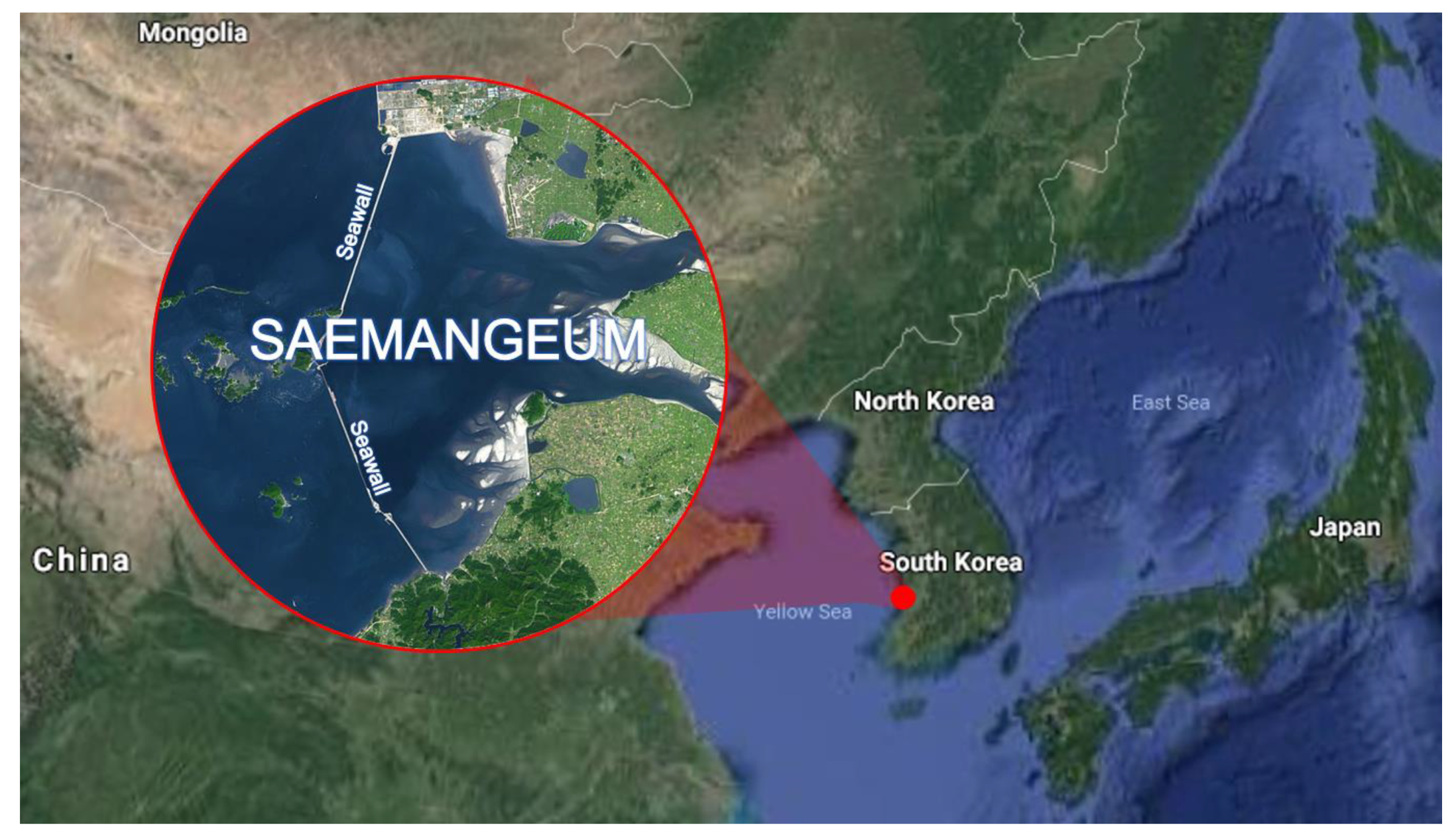


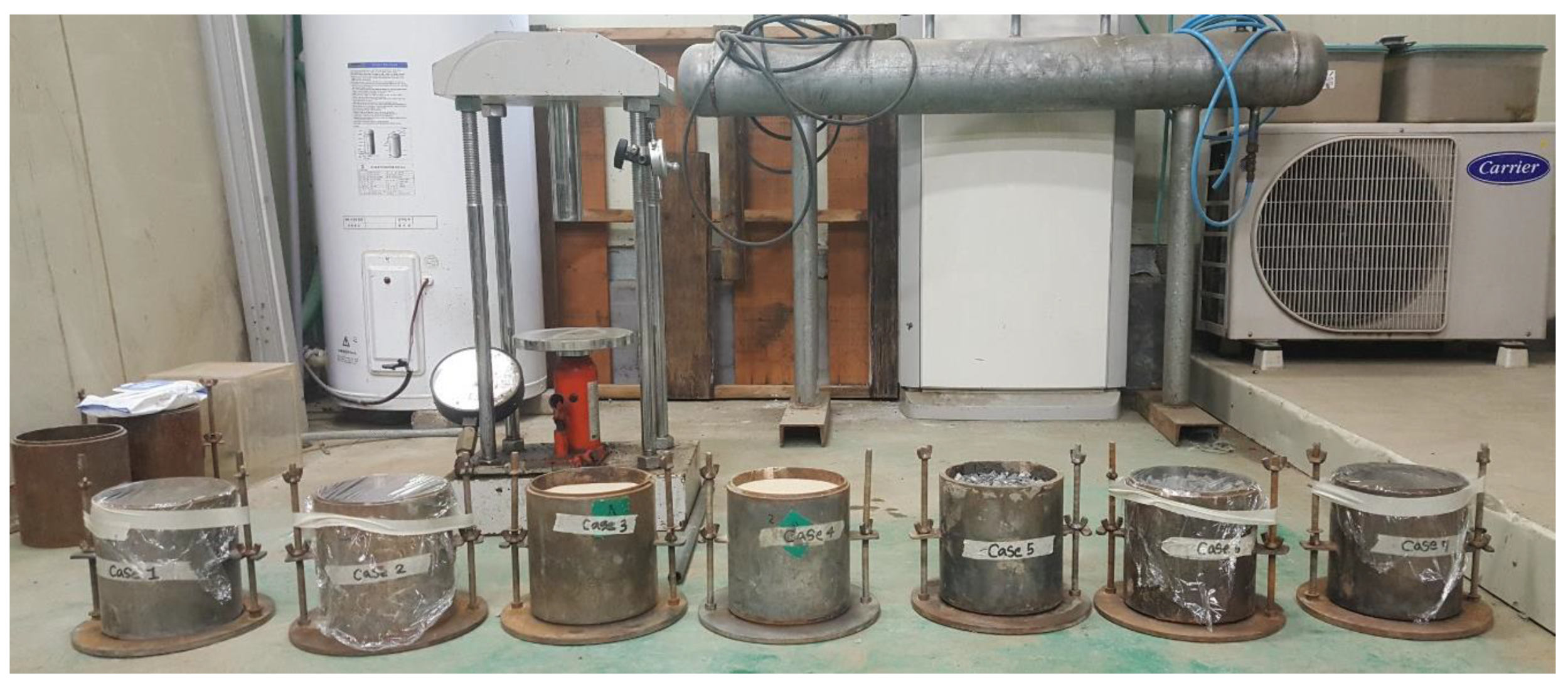
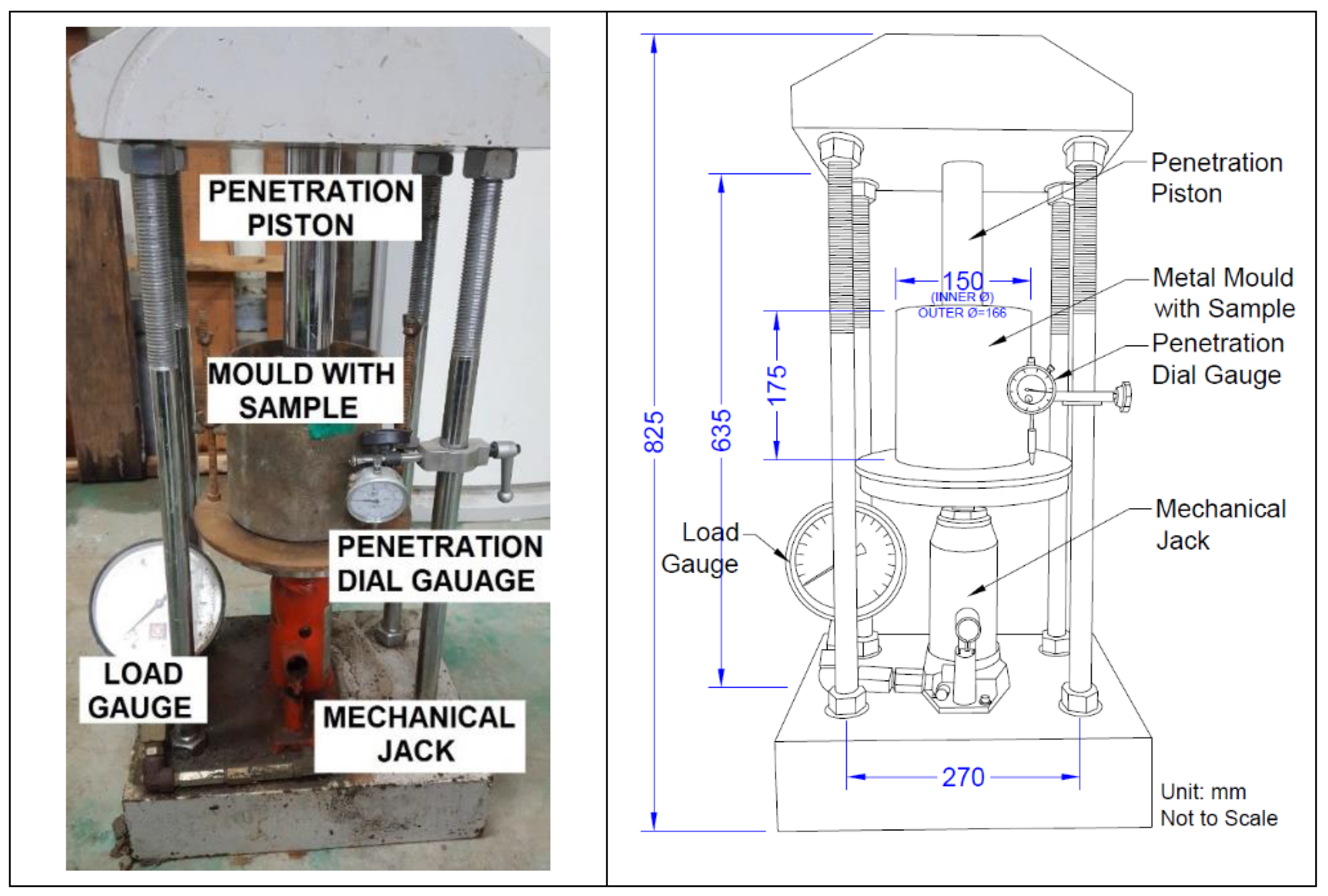
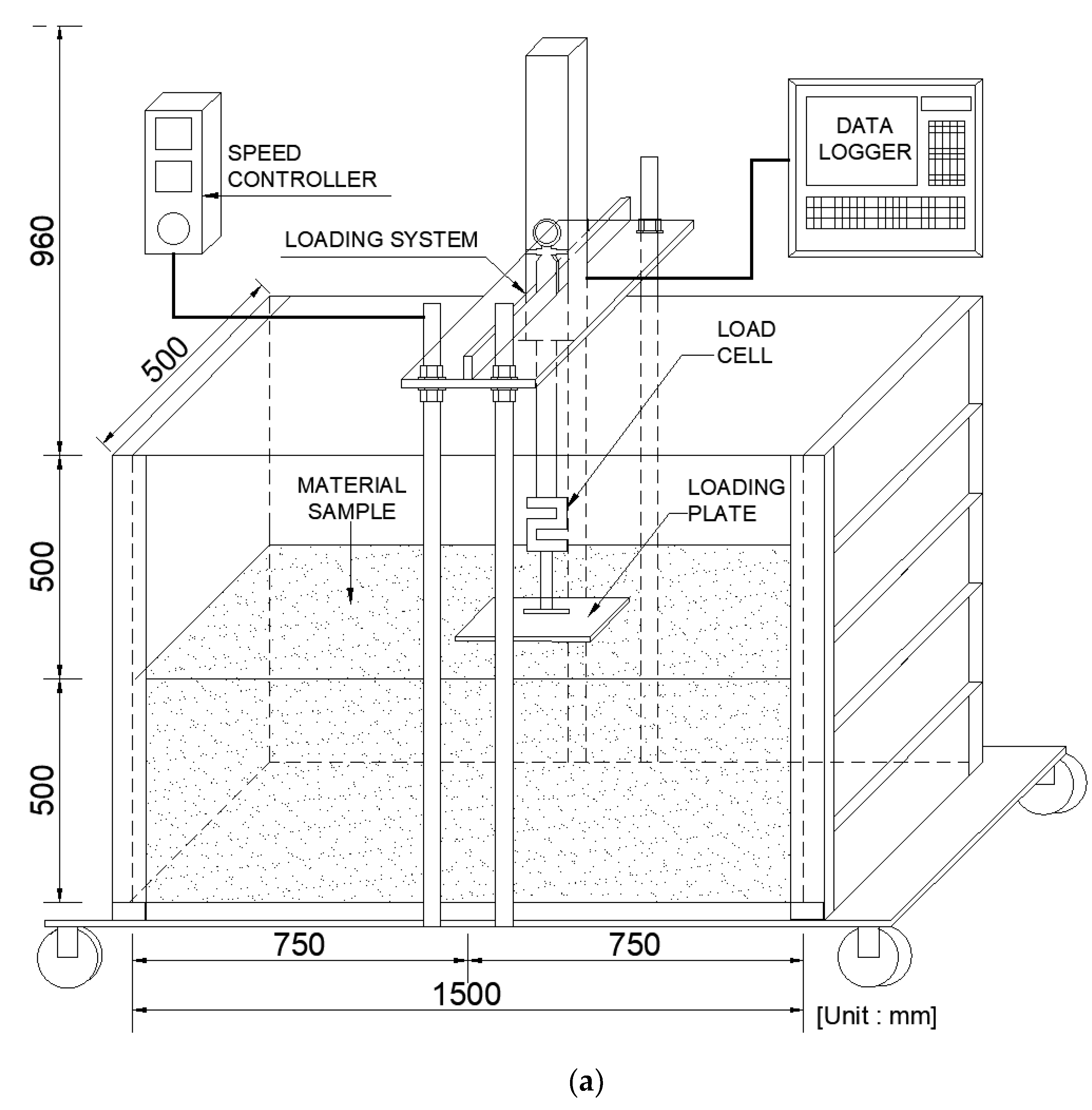
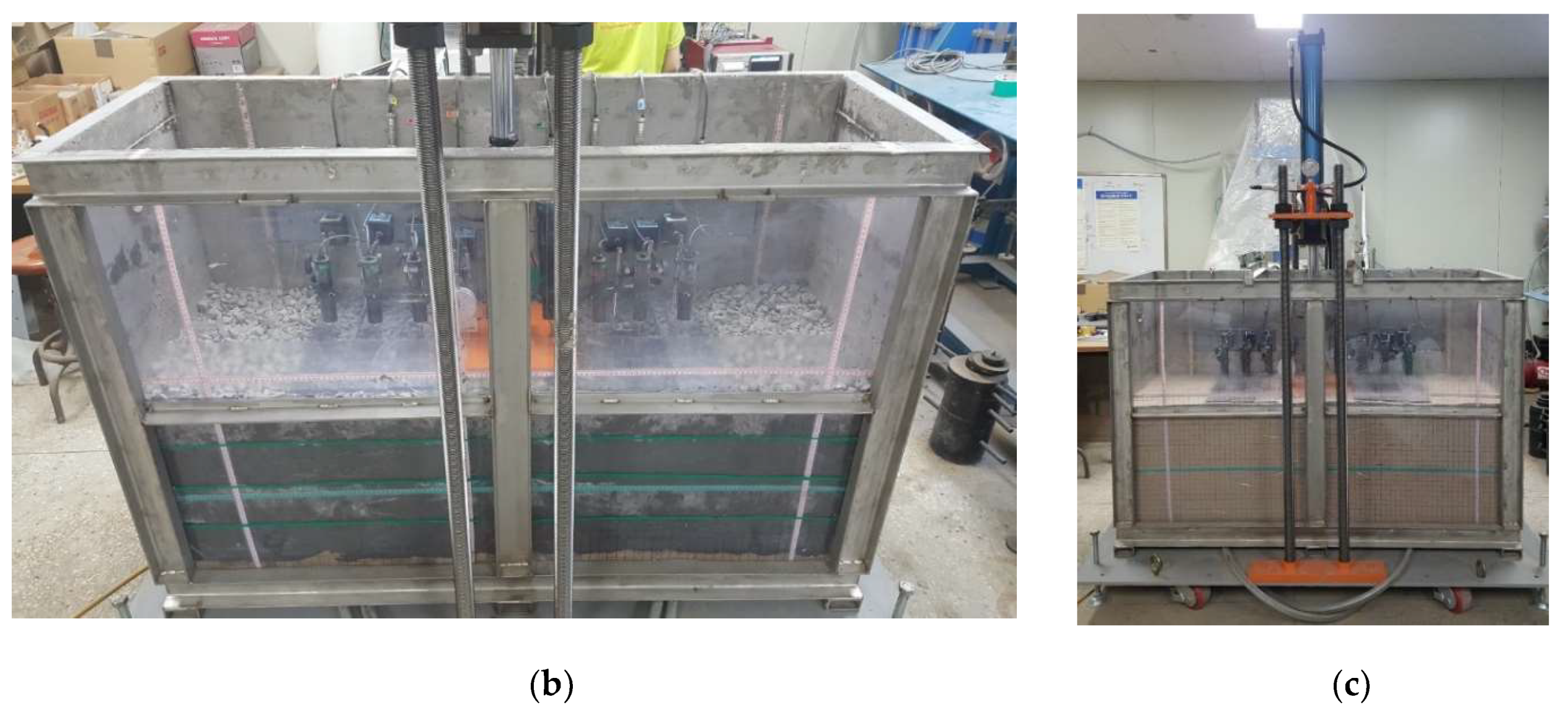


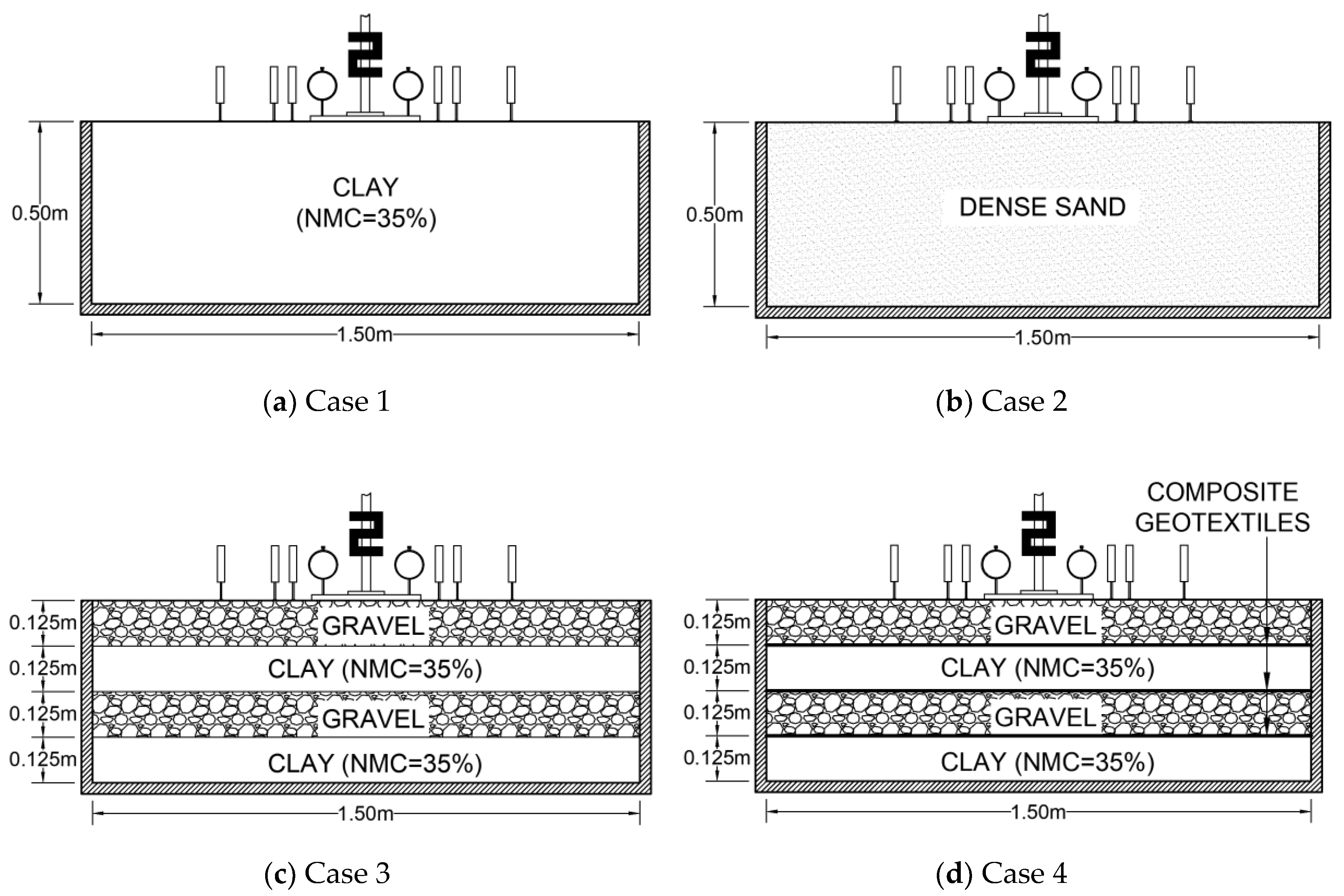
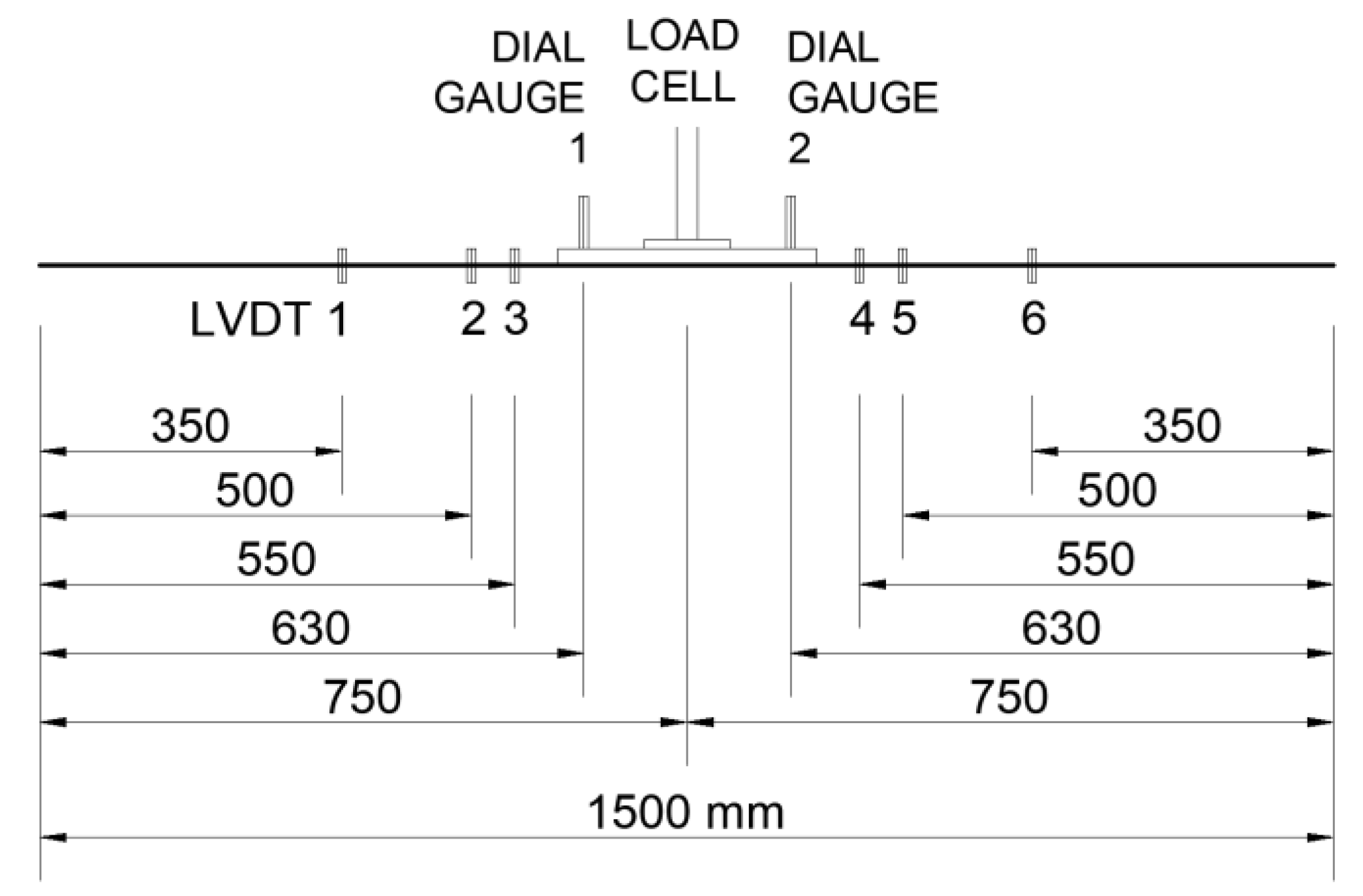
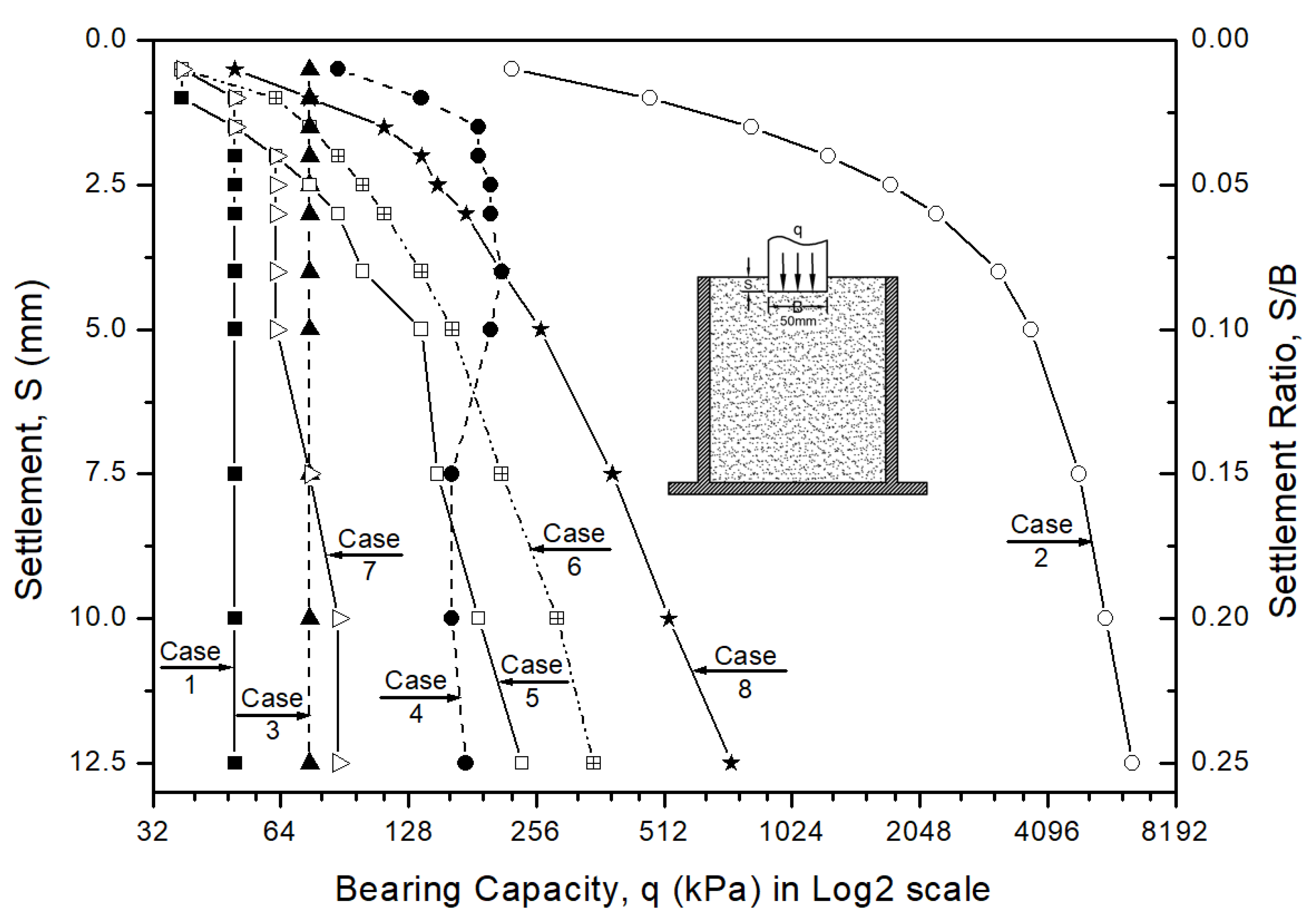
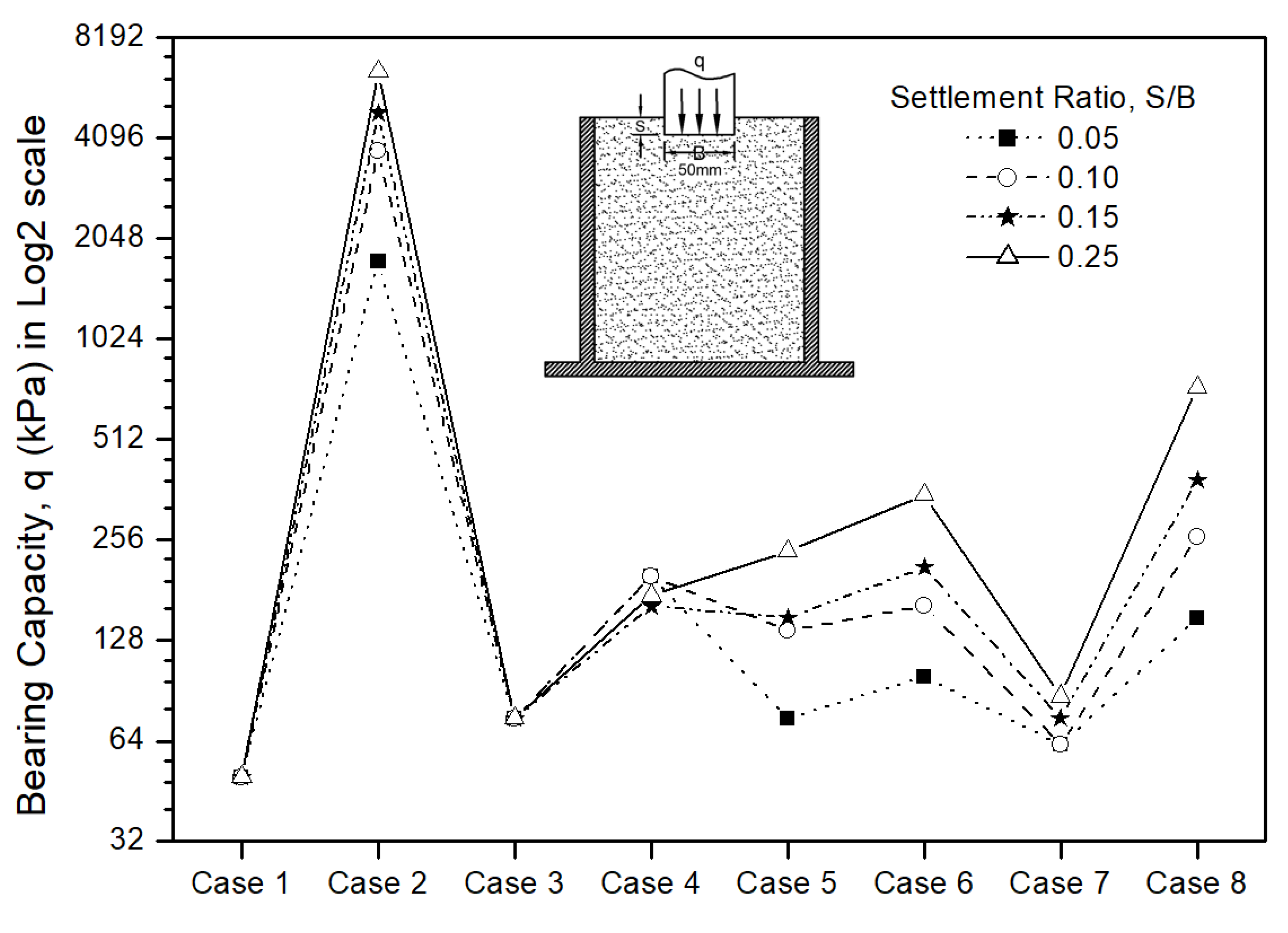
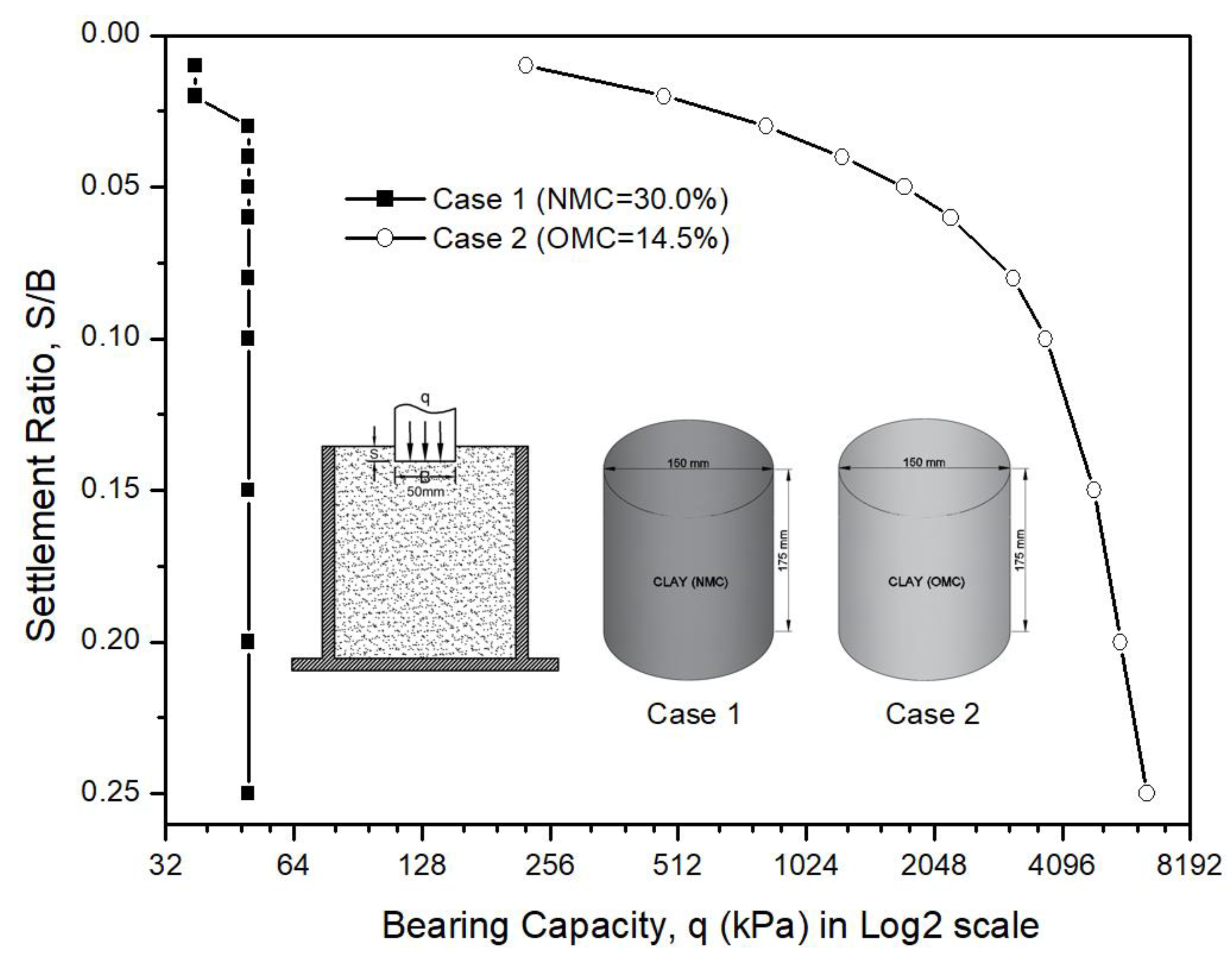
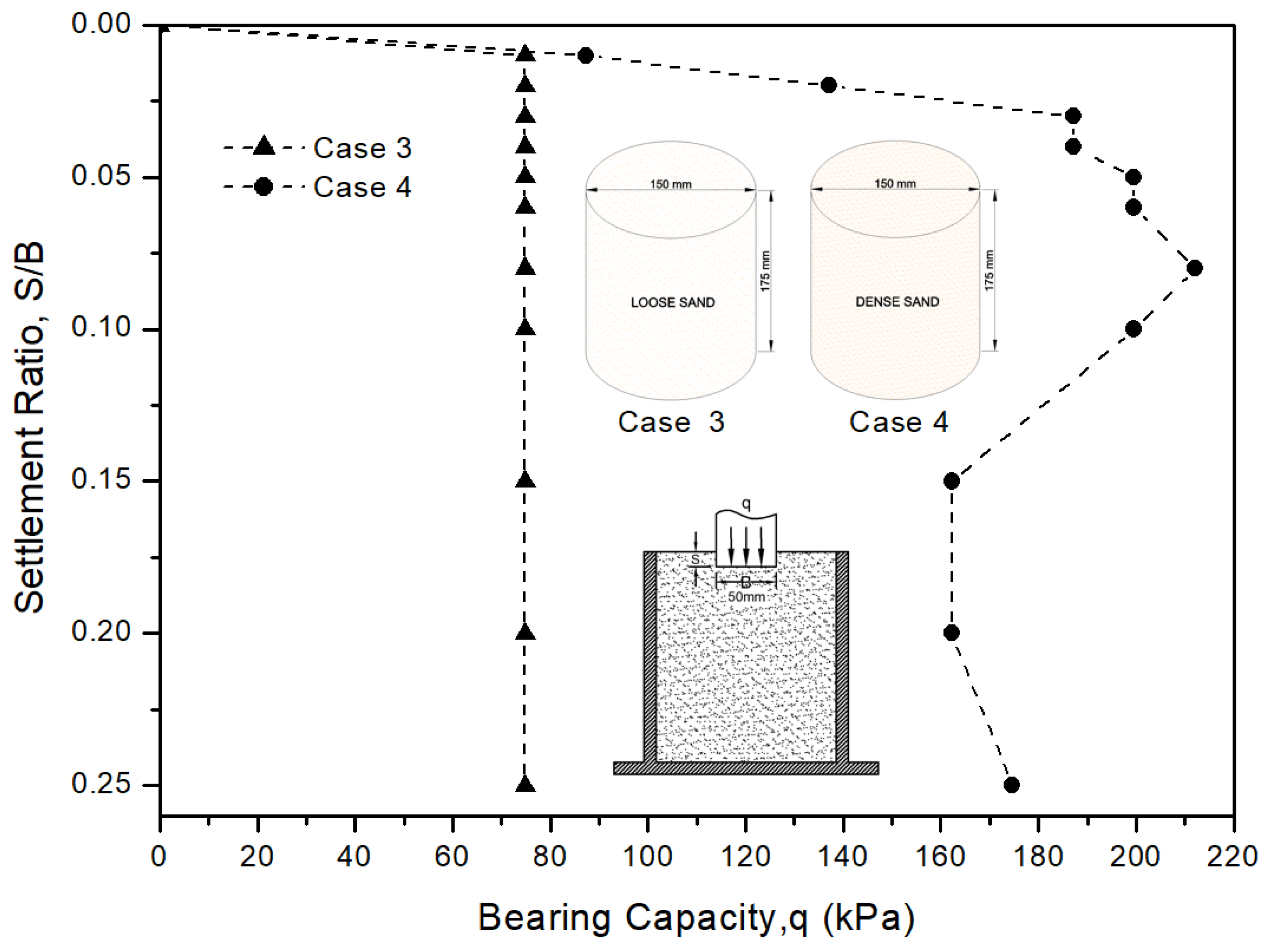
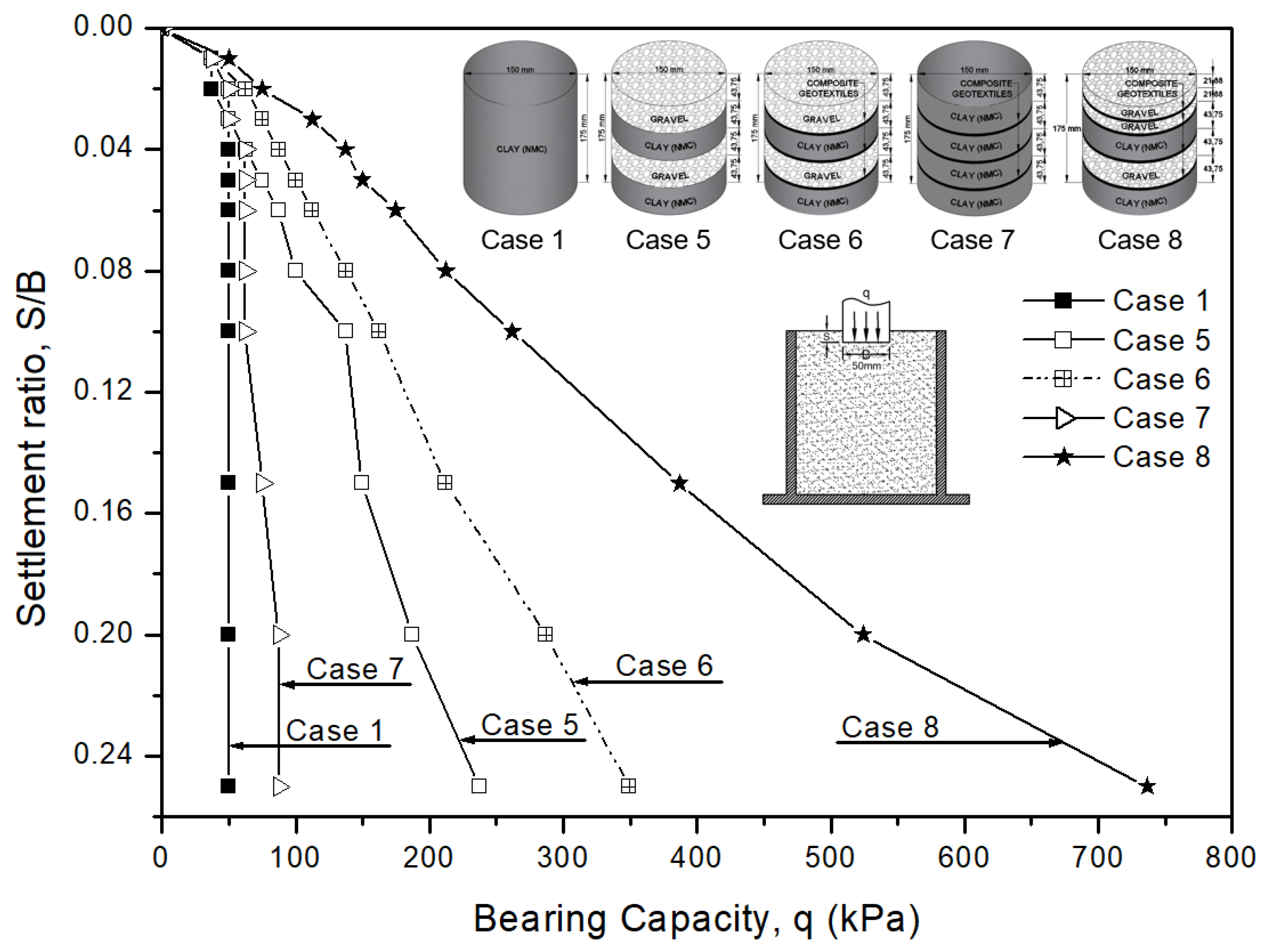
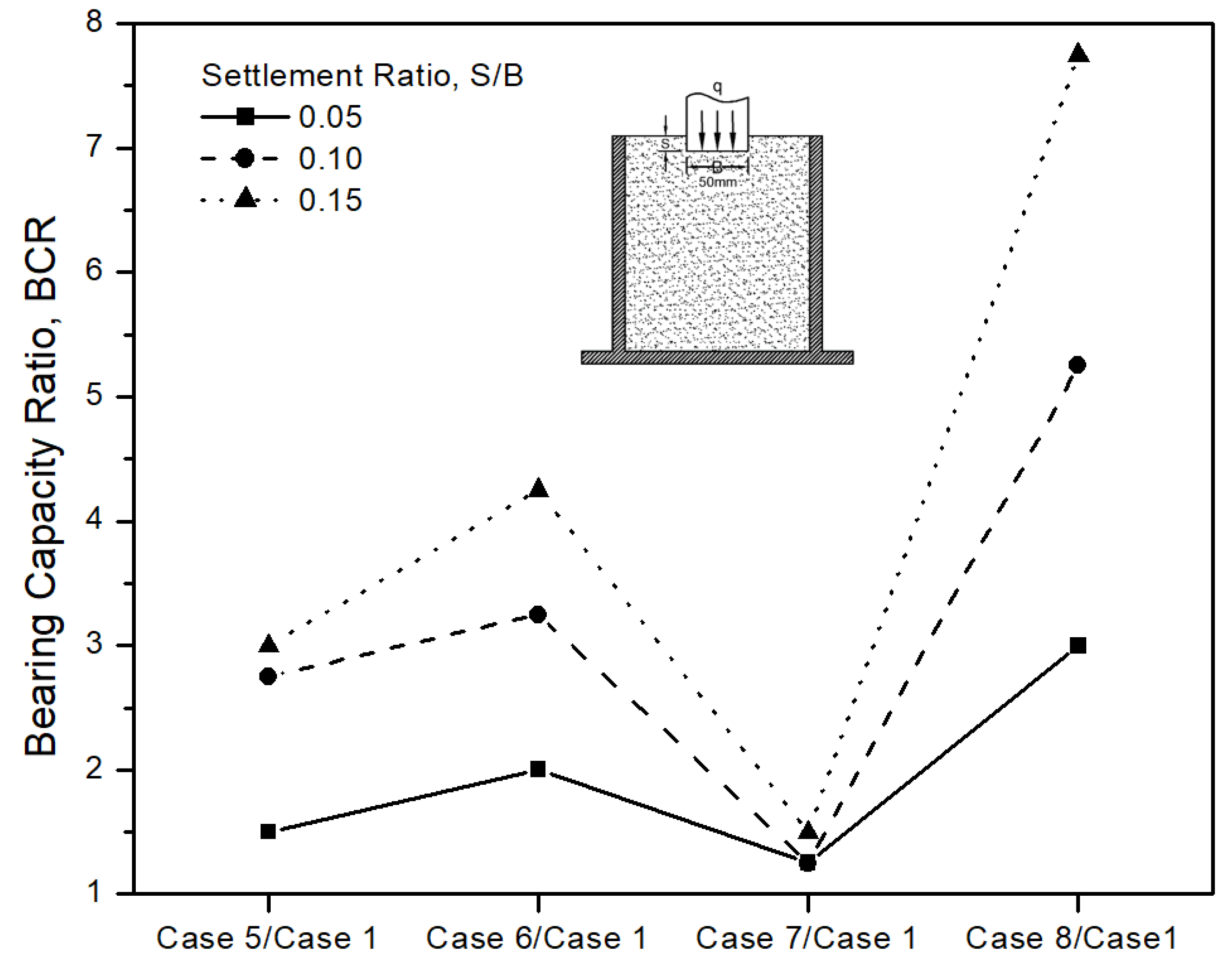
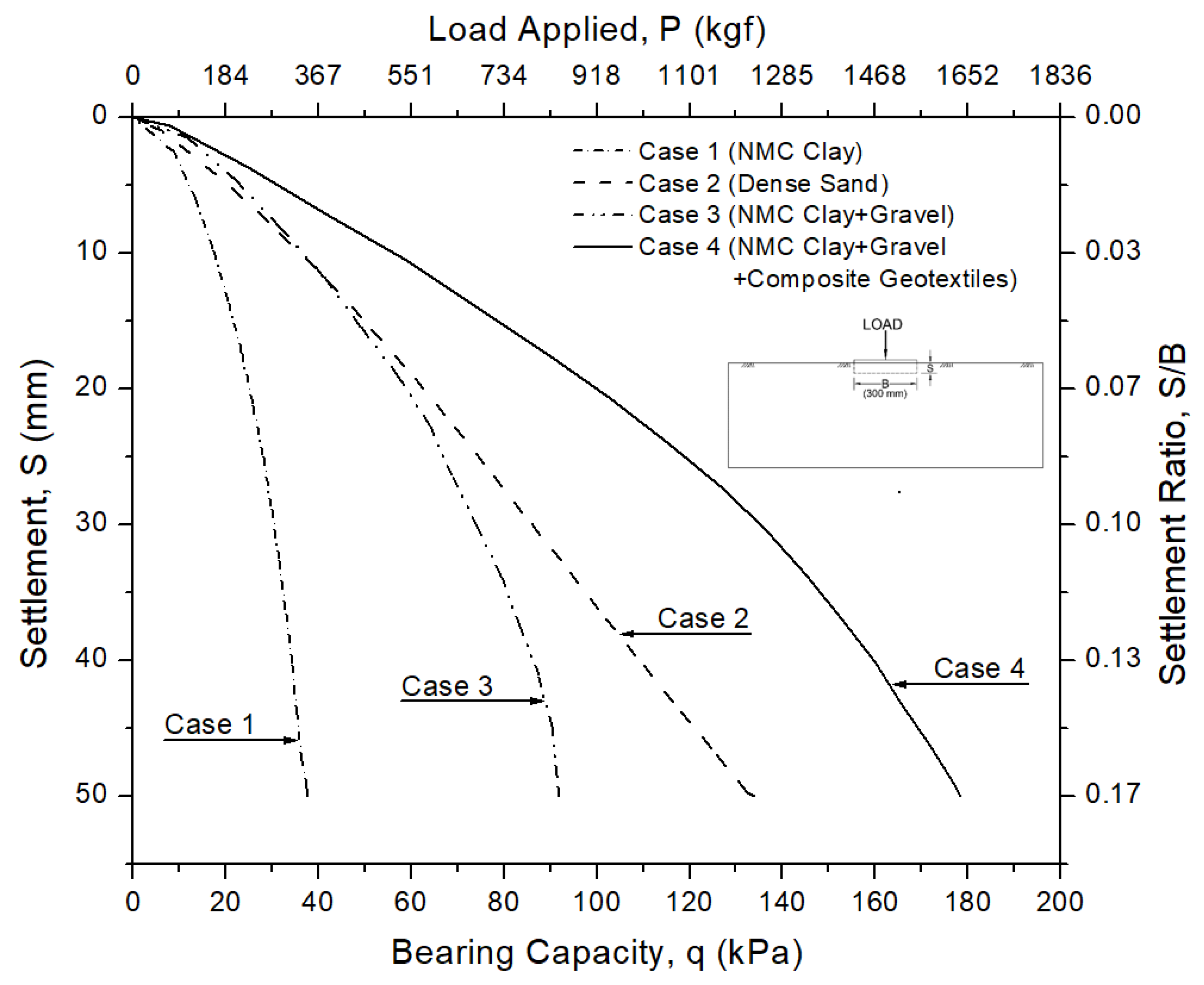
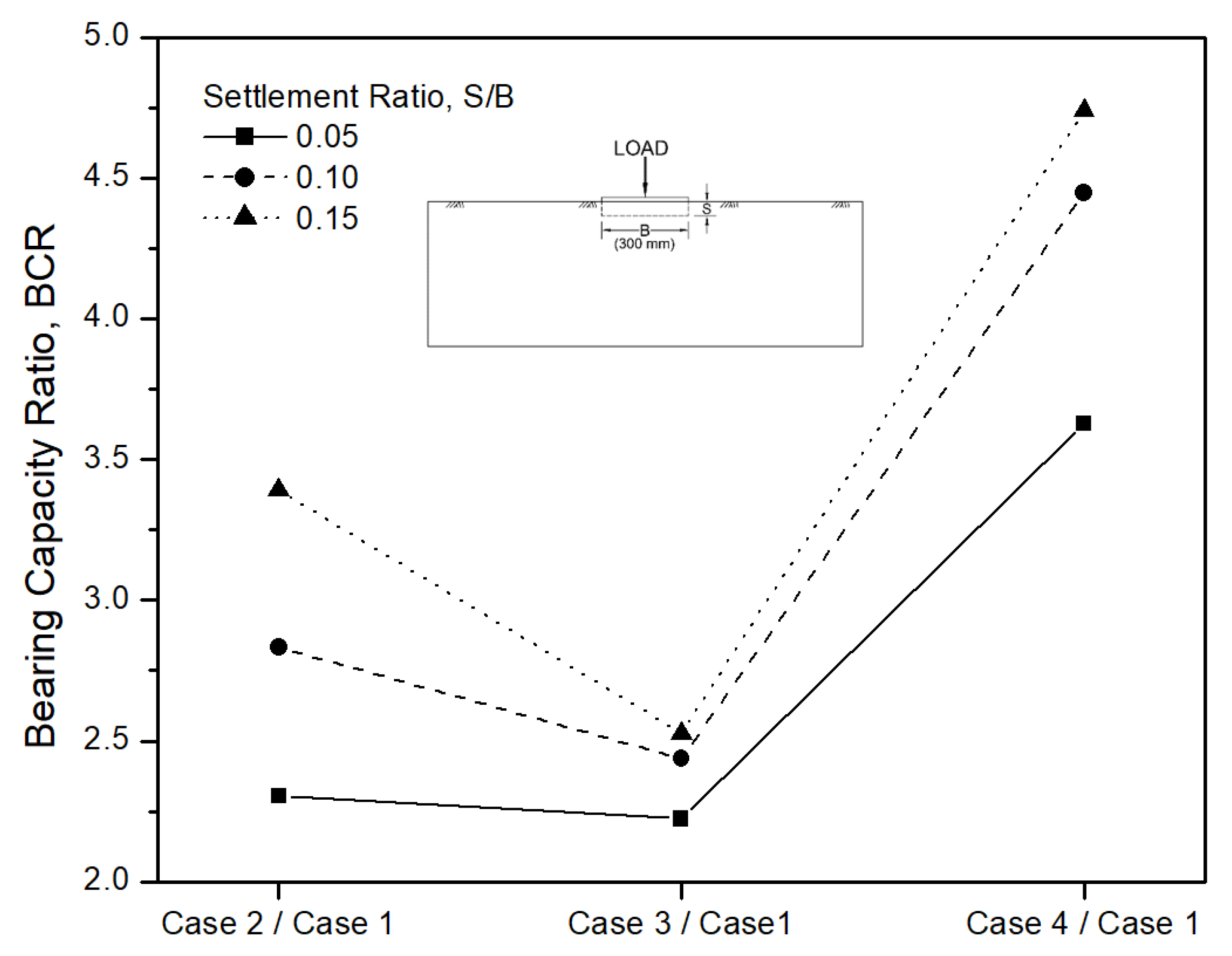
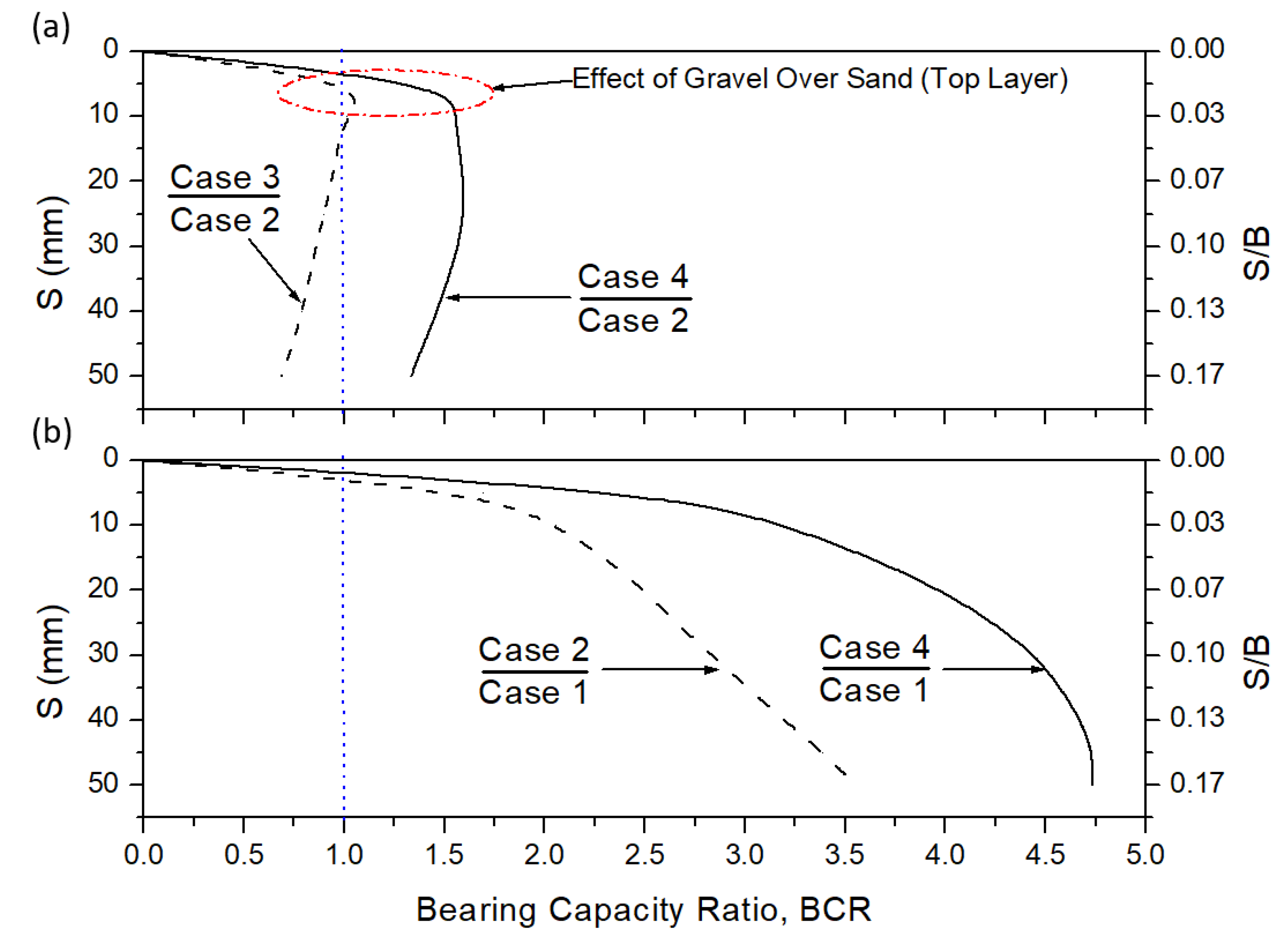
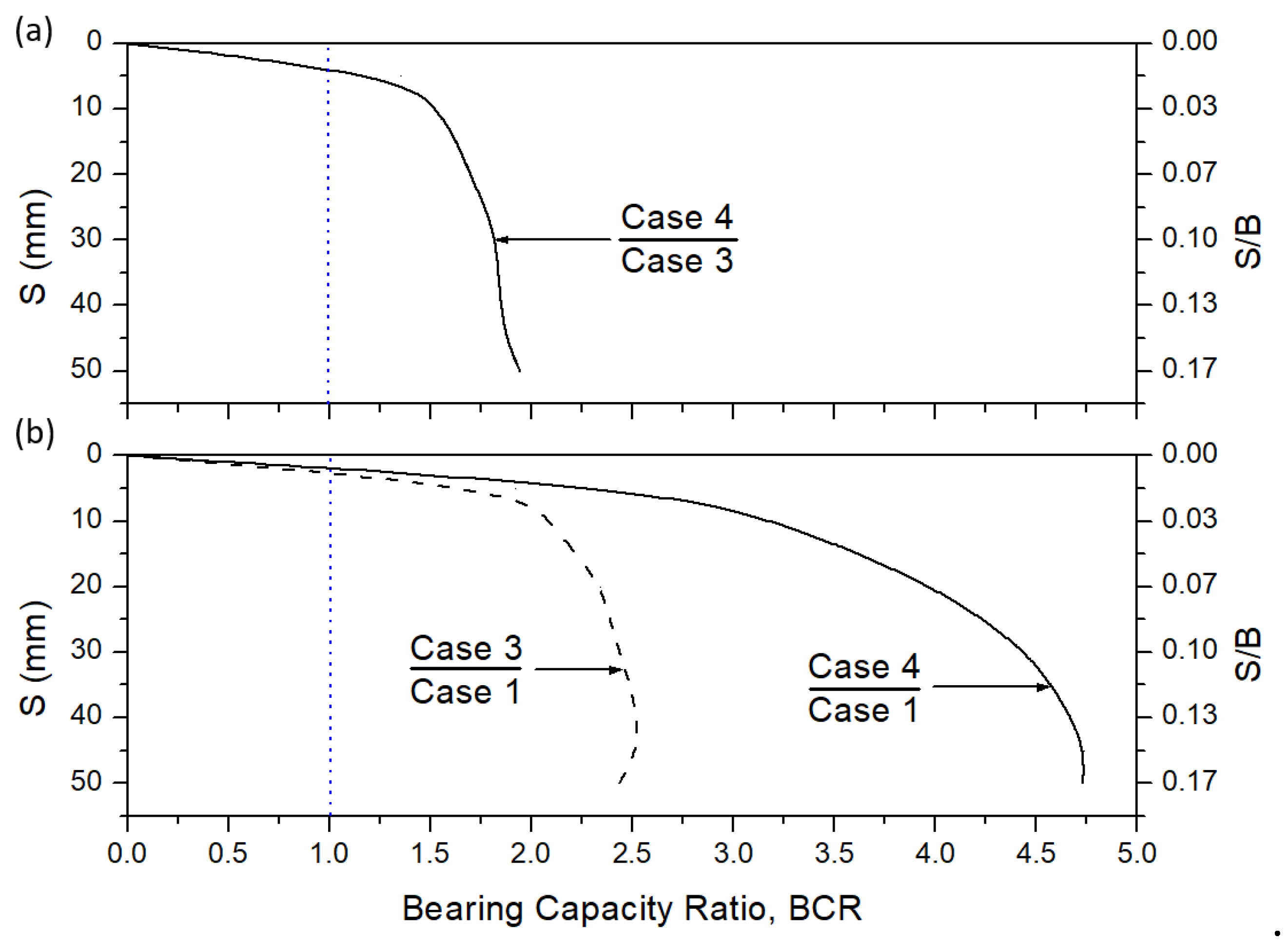
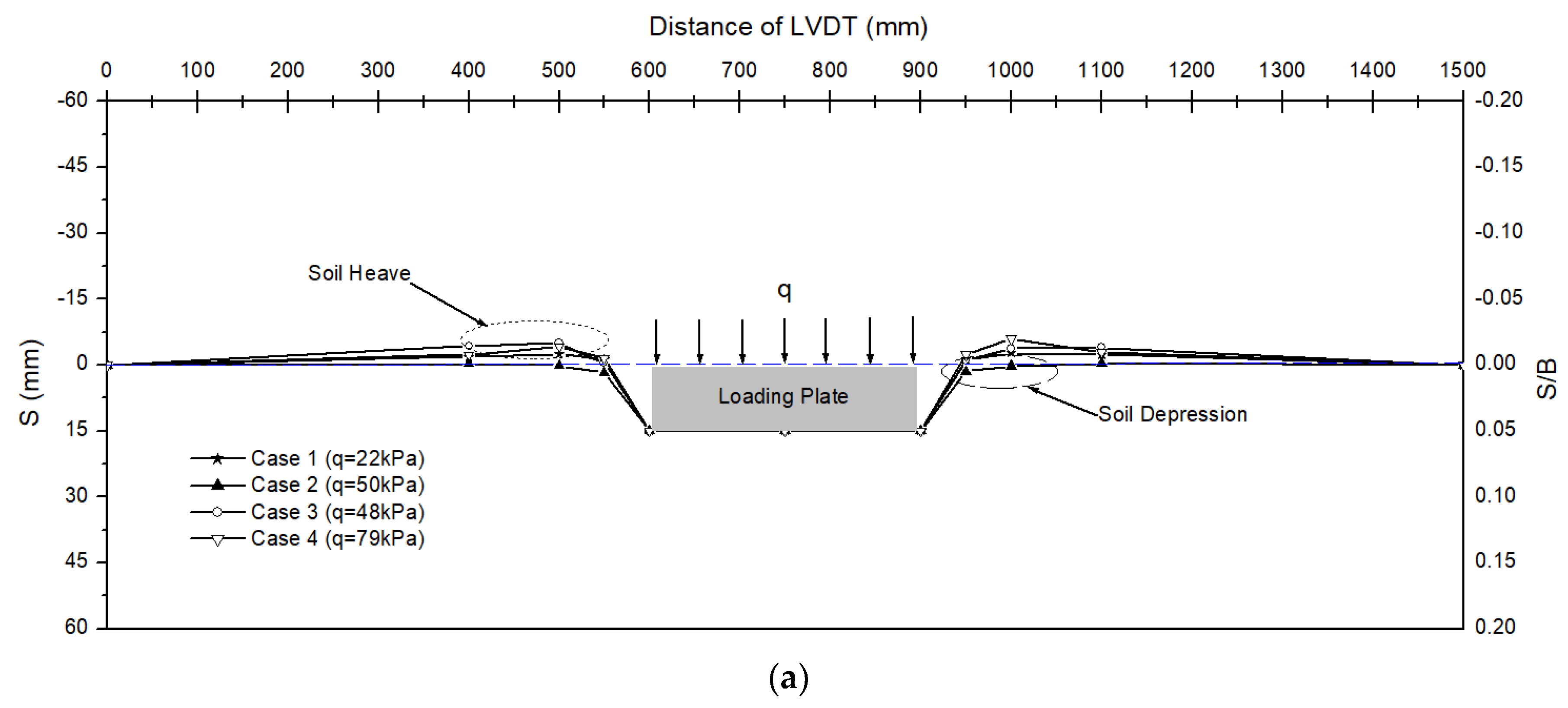


| USCS Class. | Specific Gravity, Gs | Percentage Passing #200 Sieve | Liquid Limit, LL | Plastic Limit, PL | Plasticity Index, PI | Max Dry Unit Weight, kN/m3 | Optimum Moisture Content (OMC) | Normal Moisture Content (NMC) | |
|---|---|---|---|---|---|---|---|---|---|
| NMC 1 | NMC 2 | ||||||||
| CL | 2.637 | 97% | 45.0% | 23.6% | 21.4% | 17.75 | 14.5% | 30% | 35% |
| USCS Classification | D60 (mm) | D30 (mm) | D10 (mm) | Cu | Cc | Specific Gravity | Void Ratio | Dry Unit Weight (kN/m3) | ||
|---|---|---|---|---|---|---|---|---|---|---|
| Max | Min | Max | Min | |||||||
| SP | 0.63 | 0.51 | 0.44 | 1.40 | 0.94 | 2.715 | 1.01 | 0.69 | 15.79 | 13.24 |
| USCS Class. | Gravel 1 Size Distribution (mm) | Gravel 2 Size Distribution (mm) | Unit Weight kN/m3 | Bulk Specific Gravity | ||||||||
|---|---|---|---|---|---|---|---|---|---|---|---|---|
| D60 | D30 | D10 | Cu | Cc | D60 | D30 | D10 | Cu | Cc | |||
| GP | 8.20 | 6.20 | 5.20 | 1.6 | 0.90 | 9.70 | 6.80 | 5.30 | 1.80 | 0.9 | 15.97 | 2.84 |
| Physical Characteristic | Material | Tensile Strength (kN/m) | Tensile Elongation (%) | Thickness mm | ||
|---|---|---|---|---|---|---|
| Warp | Weft | Warp | Weft | |||
| Woven and Non-Woven | PET | 156.54 | 149.05 | 37.6 | 31.4 | ≈2 |
| Parameters | Case 1 | Case 2 | Case 3 | Case 4 | Case 5 | Case 6 | Case 7 | Case 8 | |
|---|---|---|---|---|---|---|---|---|---|
| Clay | OMC 1 | - | ✓ | - | - | - | - | - | - |
| NMC 2 | ✓ | - | - | - | ✓ | ✓ | ✓ | ✓ | |
| Sand | Loose | - | - | ✓ | - | - | - | - | - |
| Dense | - | - | - | ✓ | - | - | - | - | |
| Crushed Gravel No. 1 | - | - | - | - | ✓ | ✓ | - | ✓ | |
| No. of Composite Geotextile Layers | - | - | - | - | - | 3 | 3 | 4 | |
| Compaction Method | manual surface vibration | 4.5 kgs rammer (55 blows) | none | rubber hammer (side) | manual surface vibration | manual surface vibration | manual surface vibration | manual surface vibration | |
| Unit Weight, ɣ (kN/m3) | 17.6 | 20.5 | 13.5 | 15.7 | 17.3 | 16.1 | 17.1 | 15.9 | |
| Parameters | Case 1 | Case 2 | Case 3 | Case 4 |
|---|---|---|---|---|
| Clay (NMC = 35%) | ✓ | - | ✓ | ✓ |
| Dense Sand | - | ✓ | - | - |
| Crushed Gravel No. 2 | - | - | ✓ | ✓ |
| Composite Geotextile Layer | - | - | - | 3 |
| No. of Layer(s) | 1 | 1 | 4 | 4 |
| Unit Weight (kN/m3) | 17.02 | 15.49 | 16.56 | 15.76 |
© 2020 by the authors. Licensee MDPI, Basel, Switzerland. This article is an open access article distributed under the terms and conditions of the Creative Commons Attribution (CC BY) license (http://creativecommons.org/licenses/by/4.0/).
Share and Cite
Won, M.-S.; Langcuyan, C.P.; Gao, Y.-C. A Study on the Utilization of Clayey Soil as Embankment Material through Model Bearing Capacity Tests. Appl. Sci. 2020, 10, 2315. https://doi.org/10.3390/app10072315
Won M-S, Langcuyan CP, Gao Y-C. A Study on the Utilization of Clayey Soil as Embankment Material through Model Bearing Capacity Tests. Applied Sciences. 2020; 10(7):2315. https://doi.org/10.3390/app10072315
Chicago/Turabian StyleWon, Myoung-Soo, Christine P. Langcuyan, and Yu-Cong Gao. 2020. "A Study on the Utilization of Clayey Soil as Embankment Material through Model Bearing Capacity Tests" Applied Sciences 10, no. 7: 2315. https://doi.org/10.3390/app10072315
APA StyleWon, M.-S., Langcuyan, C. P., & Gao, Y.-C. (2020). A Study on the Utilization of Clayey Soil as Embankment Material through Model Bearing Capacity Tests. Applied Sciences, 10(7), 2315. https://doi.org/10.3390/app10072315




